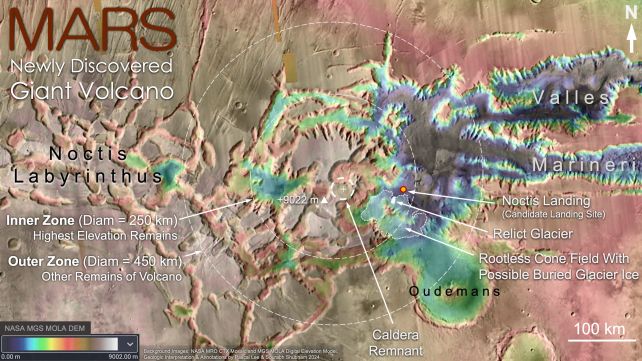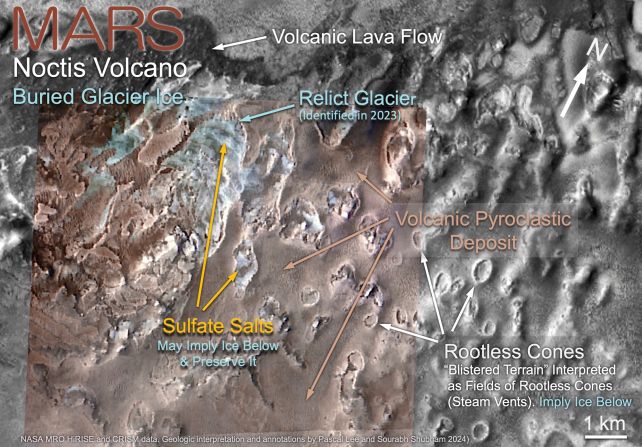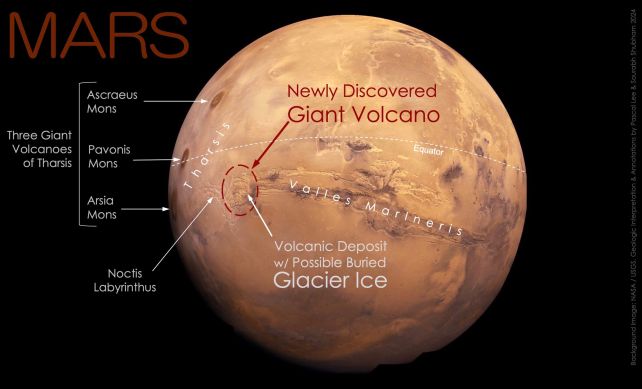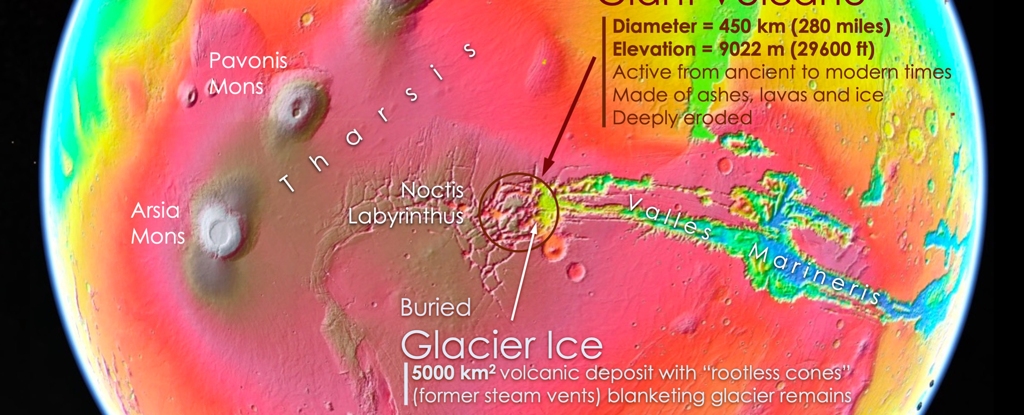Products You May Like
In a scarred and scored terrain on the face of Mars, a giant secret lurks.
There, beneath the region known as Noctis Labyrinthus (Labyrinth of the Night), scientists have found evidence of an enormous, ancient volcano – and, possibly, a buried sheet of glacier ice. The discovery makes the equatorial site an attractive option in the search for signs of ancient life on the dry and dusty planet.
Finding a hidden volcano was never part of the plan, but when a team led by planetary scientist Pascal Lee of the SETI Institute investigated a region featuring traces of an ancient glacier, they realized that’s what they were looking at – and yet it was a volcano that could be easily missed.
That’s because the volcano is so heavily eroded that it doesn’t look like one at first glance. Actually, it’s such a cunning disguise that the provisionally named Noctis volcano, or Noctis Mons, eluded us for decades.

But we’ve spotted it now, and the discovery is an exciting one.
“This area of Mars is known to have a wide variety of hydrated minerals spanning a long stretch of Martian history. A volcanic setting for these minerals had long been suspected. So, it may not be too surprising to find a volcano here,” says planetary geologist Sourabh Shubham of the University of Maryland. “In some sense, this large volcano is a long-sought ‘smoking gun’.”
And it really is a big one. The apex stands more than 9,000 meters (over 29,000 feet), and its base sprawls across 250 kilometers (155 miles). That makes Noctis Mons the seventh highest elevation feature found on Mars. The highest dormant volcano on Earth, for context, reaches an altitude of 6,893 meters (over 22,000 feet) above sea level.
There are several features that point to the volcanic nature of the crumbling mountain. Near its center, the researchers identified the remains of a caldera – a collapsed crater once filled with a lake of lava.
There are also a number of mesas in the center that form an arc shape, sketching out the conical shape of the volcano, that slopes down into lava fields that surround the broken jumble of geology. Volcanic deposits have been identified in several places; the team’s study points out a region of volcanic deposits some 5,000 square kilometers (almost 2,000 square miles) around the volcano.

The size of the volcano and the complexity of the terrain around it suggest that it was active for a very long time.
Here’s where it gets even more interesting. At the bottom of one side of the volcano, the team found a large region filled with blister-like mounds. They interpreted these mounds as a type of feature of volcanic terrain known as rootless cones.
These cones, they think, could have been produced when a layer of lava covered a surface rich in water or ice – consistent with the presence of glacial deposits.
Previous analysis of the region showed the presence of minerals that probably formed from a chemical reaction between molten volcanic rock and glacier ice. The rootless cones show similar signatures. This suggests that there still might be glacial ice buried under Noctis Labyrinthus, protected from sublimation by a blanket of volcanic rock.
How Noctis Mons came to look the way it does is probably the result of long eons of thermal erosion, glacial erosion, and fracturing as the landscape lifted up. The canyons that split the volcano appear to be the result of glaciation. We can piece this history together from satellite imagery.

What we don’t know is what is going on under the surface. Recent evidence suggests that Mars is geologically way more active than we thought, with ongoing volcanism and seismic activity.
It’s possible that Noctis Mons might still be active, if dormant, which means there could be warmth lurking just below the surface. Warmth and water from any remnant glacial ice could mean that the conditions for the emergence of life exist under Noctis Labyrinthus.
“It’s really a combination of things that makes the Noctis volcano site exceptionally exciting,” Lee says.
“It’s an ancient and long-lived volcano so deeply eroded that you could hike, drive, or fly through it to examine, sample, and date different parts of its interior to study Mars’ evolution through time.
“It has also had a long history of heat interacting with water and ice, which makes it a prime location for astrobiology and our search for signs of life. Finally, with glacier ice likely still preserved near the surface in a relatively warm equatorial region on Mars, the place is looking very attractive for robotic and human exploration.”
The team has presented their findings at the 55th Lunar and Planetary Science Conference.
